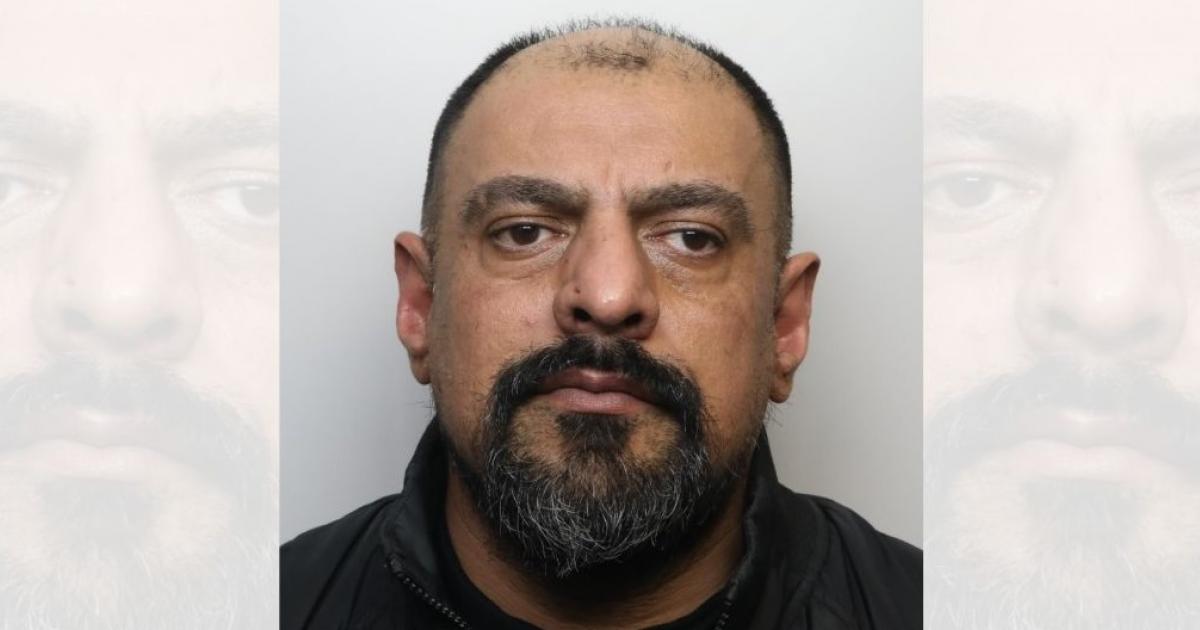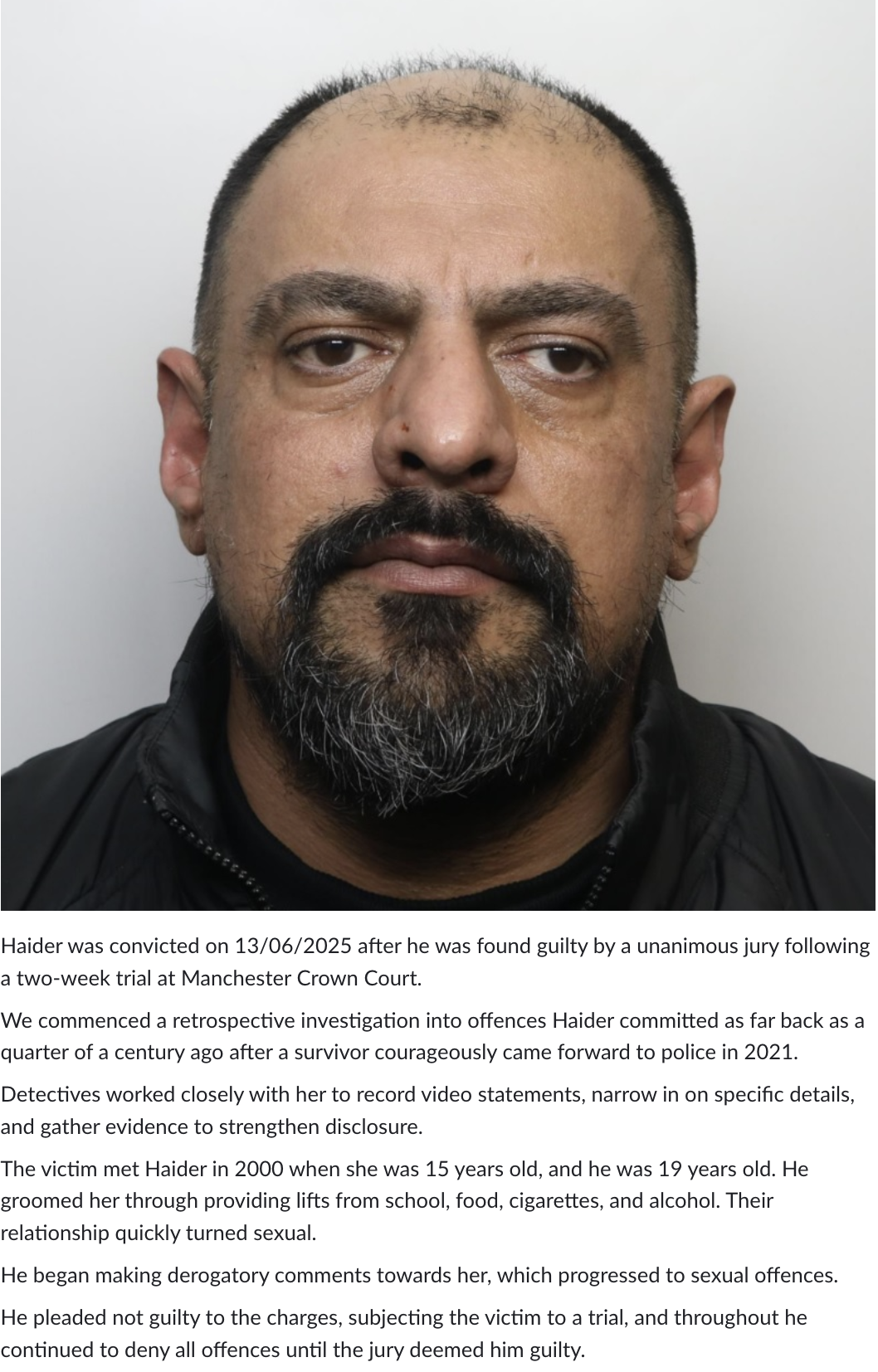Hunting White Girls At the School Gates

Why Girls Are Not Safe in School
When Greater Manchester Police announced the conviction of Suaiel Riaz Haider this summer, the headlines followed a familiar script. A man in his forties, convicted of historic offences. A victim who bravely came forward after decades of silence. A jury delivering justice, a long sentence handed down, a sex offender placed on the register for life.
The story, as told in the local press, is one of closure. Evil punished. Case closed.
But buried in the Bury Times article is a single line that should stop every parent in their tracks:
“He groomed her through providing lifts from school, food, cigarettes, and alcohol.”
There it is. The school gates. The most ordinary place in a child’s life. The boundary between education and the outside world. And it was there, in that daily transition, that this man was able to access, groom, and ultimately rape a teenage girl.
That single line is the detail the press skates past, but it is the very heart of the scandal.

The School Gate as a Hunting Ground
Predators know schools. They know the rhythm of dismissal times. They know the streets where pupils gather, the bus stops where teenagers loiter, the quiet corners where supervision drops away. For decades, survivors have testified that they were first approached outside their schools. Offered cigarettes. Given alcohol. Promised lifts.
Haider’s methods were not new. They were textbook. He provided transport, food, small luxuries that appealed to a young girl. He created dependency. The school gate was his access point, his hunting ground.
The obvious question is: what did the school know, and what did it do?
The Vagueness That Protects Institutions
The Bury Times gives us a tidy narrative: brave survivor, professional police, guilty verdict. But the vagueness around the school setting is striking. There are no details about how often Haider waited at the gates, whether teachers noticed, whether friends raised concerns. No reference to whether Haider acted alone or if other girls were targeted.
This vagueness isn’t accidental. It shields the institution. If the public were told plainly that a grown man was repeatedly collecting a schoolgirl, parents would ask: Why didn’t the school stop it? Where was the safeguarding? Who was responsible?
By blurring the detail, the story becomes an individual crime rather than an institutional failure.
Where Were Greater Manchester Police in 2000?
The article says the victim came forward in 2021. But it is silent on whether she ever tried to report at the time. That silence is telling. The official GMP press release is equally vague, only adding that the victim was aged 15 whilst Haider was aged 19.

Across Greater Manchester, girls did report. They told police, social workers, teachers. They were ignored, dismissed, or blamed. In some cases officers wrote them off as making “lifestyle choices.” In others, police feared the “community impact” of pursuing offenders.
So are we supposed to believe that in this case, in Bury in 2000, the victim said nothing? Or is it more likely she did speak up, and GMP failed to act. Just as they did so many other times?
By avoiding the question, the press lets GMP pose as professional and diligent, when their record shows a pattern of denial and cover-up.
The public deserves the truth: did this girl ever try to report the abuse when it was happening? And if she did, what did GMP do about it?
Lone Predator, or Part of a Network?
There is another silence. The article frames Haider as a lone offender. But history tells us otherwise.
From Rochdale to Telford, predators operated in groups. Girls were trafficked between men, shared, passed from car to car and house to house. This is not theory. It is established fact.
So are we really to believe Haider acted entirely on his own? That he groomed and repeatedly raped a schoolgirl without ever involving anyone else? That he never trafficked her, never handed her off, never bragged to peers? That other men were not also lined up outside the same school? And what happened, only happened to one little girl?
It stretches credibility. And yet the reporting doesn’t even raise the possibility. By presenting him as a solitary abuser, the story closes down the bigger questions: were there accomplices, and are they still free? Were there other victims, still waiting for justice?
If you believe this work matters, please consider upgrading your subscription and supporting me. I don’t have corporate sponsors or party backing - only readers like you. Your support allows me to keep exposing the cover-up and fighting to make sure the Pakistani Rape Gangs, knowing they are protected, can no longer drag children into their cars at the school gates.
What Schools Should Have Done And Must Do Now
Haider’s case exposes the truth: schools cannot treat grooming as an abstract social issue that happens “out there.” It happens at their gates. That means every school must move beyond generic safeguarding policies and adopt a dedicated Anti-Grooming Gang Strategy.
This strategy should be as visible and mandatory as fire drills or anti-bullying policies. It must include:
- Visible safeguarding at the gates
Staff should be present at dismissal and arrival times, not just to manage pupils but to watch for predatory behaviour. Unknown adults loitering, unfamiliar cars waiting, or older men collecting girls should be challenged, documented, and escalated. - Clear reporting and escalation systems
Any observation of a child leaving with an older male, repeated loitering by adults, or reports from peers are not minor incidents. They are immediate red flags. These records should be reported internally and to external safeguarding boards. - Direct education for pupils
Students must be taught exactly how grooming works: the cigarettes, the lifts, the gifts, the flattery. They must know that if this happens to them, it is not their fault, and they must know who to tell. This cannot be a one-off assembly. It must be a structured programme delivered across year groups. - Communication with parents and communities
Families must be kept informed of risks and patterns. A predator hanging around school gates is not private information. It is a community safety issue. Parents should be treated as partners, not kept in the dark. - Police and school partnerships for disruption
Schools must demand action from local police. The excuse that “we can’t intervene until a crime is committed” is not acceptable. The presence of predators outside schools should trigger immediate disruption measures. - Staff training and accountability
Every adult working in a school must be trained to recognise grooming. Just as they are trained for fire safety, they should be trained for grooming awareness. Inspections should test the robustness of these strategies, and schools should be held accountable for failings.
Why Girls Are Not Safe in School
When a predator can use the school run as his entry point, when institutions fail to notice or act, when reporting smooths over the scandal with vagueness, the conclusion is stark: girls are not safe in school.
The safety parents assume is not guaranteed. The vigilance we expect from teachers and safeguarding leads is too often absent. And the predators know it. They know that between the classroom and the street, between the bell and the bus stop, lies a gap in protection wide enough to swallow lives.
The Hard Truth
The hard truth is that Haider’s conviction is not just a story of justice served. It is a story of institutional failure ignored. It is a story of a school that should have acted but didn’t. It is a story of GMP, a force with a record of betraying victims, allowed to present itself as heroic. It is a story of a press that chose vagueness over clarity, and reassurance over outrage. It is a story of the continuing cover up. And yes, read the article again. You will see no reference made to the race of the child. Now why would that be?
Until schools adopt dedicated anti-grooming gang strategies, until police are forced to answer whether they ignored victims at the time, and until journalists stop burying the most important details, the next predator will be waiting at the school gate, where the next girl walks out of class into danger.
They silenced victims. They erased evidence. They persecuted whistleblowers, buried official reports, and protected predators. They thought no one would fight back. They were wrong.
I’m not Maggie Oliver. I’m not Tommy Robinson. I’m a political campaigner, and my mission is clear: expose the cover-up, explain the corruption, educate the nation, and show people how to fight back.
That’s why they tried to jail me. That’s why they tried to sue me. That's why Pakistani gangsters and Islamists with direct links to the Labour Party try to silence me. They all know how dangerous the truth is.
But I can’t do this alone. Every day I keep going, more people wake up. Every day we grow stronger. If my words have ever helped you make sense of this broken system, if they’ve ever made you feel seen, heard, or hopeful, then please don’t scroll past.
🔴 Join the fight.
Subscription is 100% free. I ask those that can afford to do so, to support me with just £3/month or £30 for the full year to help keep this campaign alive.
🔴 Prefer a one-off contribution?
👉 http://BuyMeACoffee.com/recusantnine
👉 http://paypal.me/RecusantNine
We are closer than ever. Don’t let them get away with it. Stand with me.
– Raja 🙏
